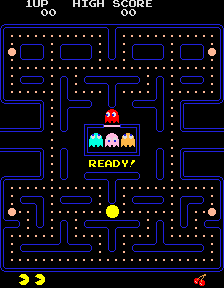Pac-Man facts for kids
Quick facts for kids Pac-Man |
|
|---|---|

The classic Pac-Man
|
|
| Developer(s) | Namco |
| Publisher(s) |
|
| Designer(s) | Toru Iwatani |
| Programmer(s) | Shigeo Funaki |
| Composer(s) | Toshio Kai |
| Series | Pac-Man |
| Platform(s) | Arcade, Apple II, Atari 2600, Atari 5200, Atari 8-bit, Commodore 64, VIC-20, IBM PC, Intellivision, TI-99/4A, ZX Spectrum, NES, Game Boy, Game Boy Color, Game Gear, Neo Geo Pocket Color |
| Release date(s) |
|
| Genre(s) | Maze |
| Mode(s) | Single-player |
| Cabinet | Standard upright, mini-upright and cocktail |
| Arcade system | Namco Pac-Man |
| CPU | 1 × Z80 @ 3.072 MHz |
| Sound | Namco WSG (three-channel mono) |
| Display | Vertically oriented, 224 × 288, 16 palette colors |
Pac-Man is an arcade video game that was made by Namco. It was released in 1980, and became very popular in the history of games.
In Pac-Man, the player makes a Pac-Man, a yellow disc, move around a maze. The goal is to eat every yellow pellet (circles) while not getting caught by the ghosts/monsters. For extra points, fruits that appear can also be eaten. When Pac-Man eats a white pellet, the ghosts turn blue and can be eaten. Even though the game has 256 stages, the last level can not be finished due to a problem with the creation of the game.
Game development began in early 1979, directed by Toru Iwatani with a nine-man team. Iwatani wanted to create a game that could appeal to women as well as men, because most video games of the time had themes of war or sports. Although the inspiration for the Pac-Man character was the image of a pizza with a slice removed, Iwatani has said he rounded out the Japanese character for mouth, kuchi (Japanese: 口). The in-game characters were made to be cute and colorful to appeal to younger players.
There were many sequels and remakes based on the game. Hanna-Barbera made a animated TV show airing on ABC in the early 1970s. The game was also part of Namco Museum games. There is a Namco Museum Remix for the Wii.
Contents
Gameplay
Pac-Man is an action maze chase video game; the player controls the eponymous character through an enclosed maze. The objective of the game is to eat all of the dots placed in the maze while avoiding four colored ghosts—Blinky (red), Pinky (pink), Inky (cyan), and Clyde (orange)—who pursue Pac-Man. When Pac-Man eats all of the dots, the player advances to the next level. Levels are indicated by fruit icons at the bottom of the screen. In between levels are short cutscenes featuring Pac-Man and Blinky in humorous, comical situations.
If Pac-Man is caught by a ghost, he loses a life; the game ends when all lives are lost. Each of the four ghosts has its own unique artificial intelligence (A.I.), or "personality": Blinky gives direct chase to Pac-Man; Pinky and Inky try to position themselves in front of Pac-Man, usually by cornering him; and Clyde switches between chasing Pac-Man and fleeing from him.
Placed near the four corners of the maze are large flashing "energizers" or "power pellets". When Pac-Man eats one, the ghosts turn blue with a dizzied expression and reverse direction. Pac-Man can eat blue ghosts for bonus points; when a ghost is eaten, its eyes make their way back to the center box in the maze, where the ghost "regenerates" and resumes its normal activity. Eating multiple blue ghosts in succession increases their point value. After a certain amount of time, blue-colored ghosts flash white before turning back into their normal forms. Eating a certain number of dots in a level causes a bonus item—usually a fruit—to appear underneath the center box; the item can be eaten for bonus points. To the sides of the maze are two "warp tunnels", which allow Pac-Man and the ghosts to travel to the opposite side of the screen. Ghosts become slower when entering and exiting these tunnels.
The game increases in difficulty as the player progresses: the ghosts become faster, and the energizers' effect decreases in duration, eventually disappearing entirely. An integer overflow causes the 256th level to load improperly, rendering it impossible to complete.
Perfect score
A perfect score on the original Pac-Man arcade game is 3,333,360 points, achieved when the player obtains the maximum score on the first 255 levels by eating every dot, energizer, fruit and blue ghost without losing a life, then uses all six lives to obtain the maximum possible number of points on level 256.
The first person to achieve a publicly witnessed and verified perfect score without manipulating the game's hardware to freeze play was Billy Mitchell, who performed the feat on July 3, 1999. Some record keeping organizations removed Mitchell's score after a 2018 investigation by Twin Galaxies concluded that two unrelated Donkey Kong score performances submitted by Mitchell had not used an unmodified original circuit board. As of July 2020, seven other gamers had achieved perfect Pac-Man scores on original arcade hardware. The world record for the fastest completion of a perfect score, according to Twin Galaxies, is held by David Race with a time of 3 hours, 28 minutes, 49 seconds.
Images for kids
-
Creator of Pac-Man, Toru Iwatani, at the 2011 Game Developers Conference
See also
 In Spanish: Pac-Man para niños
In Spanish: Pac-Man para niños




